The term “molecular cuisine” appeared in the last century, but is poorly studied by visitors to familiar restaurants. Everything in it is ephemeral and unusual to look at — from the size of the dishes themselves to their content. Molecular cuisine dishes remain the main highlight for jaded gourmets and able to surprise anyone. The improvement of molecular cuisine continues to this day, while experts continue to invent new ways to surprise and delight their connoisseurs. Where did the concept of molecular cuisine come from, what dishes is it famous for?
Dishes of molecular cuisine: history, types and concepts
Molecular cuisine is one of the branches of trophology that studies the physical and chemical processes that occur during cooking.
Terminology “molecular gastronomy” was formulated in the early nineties by two scientists: the physicist Nicolas Kurti and the chemist Herve Thieset – people who are fond of the scientific side of cooking.
During the preparation of molecular cuisine, experts take into account the processes during which the transformation of ingredients occurs during cooking. For example, in molecular cuisine, cooking temperature is more important than cooking time cooking.
Molecular cuisine has changed its name several times in recent years in order to attract more supporters and become clearer and closer to as many people as possible:
- avant-garde;
- provocative;
- techno-emotional cooking;
- experimental cooking;
- physical kitchen.
Dishes of molecular cuisine: features of spherification
Spherification – a method of preparing molecular cuisine dishes in the form of spheres (ideally correct balls of various diameters). Spheres can be of different sizes, flavors – from sweet to savory, but they always remain light, transparent in appearance and have a rich taste.
The proposed recipe for carrot-ginger caviar, prepared by the method of molecular cuisine called "spherification", can be a wonderful snack or side dish. The beautiful, unusual look of familiar products will surprise you and make you look at your table in a new way.
- Carrot-ginger caviar
Ingredients:
- 700 gr. carrots;
- 50 gr. ginger;
- 2 gr. alginate;
for calcium water
- 6.5 gr. calcium;
- 1 l. water.
Technology:
- Make juice from root crops. Strain and add alginate. Beat, refrigerate for 1 hour to release air bubbles.
- Prepare calcium water: dissolve calcium in water, pour into a deep tray with a rim height of at least 5 cm.
- Drip the prepared juice with a syringe into calcium water for spherification, hold for 1 minute, take out the eggs with a spoon, rinse in clean water. Ready-made eggs can be stored in juice (carrot + ginger) in the refrigerator.
- Place the caviar on appetizer serving plates. Serve with fresh herbs to taste (sprig of parsley or dill).
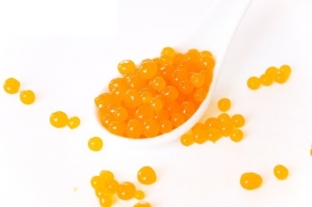
As a dessert, fruits or sweets with fruit and berry sauce are often offered. Molecular cuisine dishes turn an ordinary dessert into something unexpected, but with the taste of a familiar delicacy – Let's make melon caviar.
- Molecular melon caviar
Ingredients:
- 250 ml. melon juice;
- 2 gr. alginate;
for calcium water
- 0.5 l. water;
- 2.5 gr. calcium.
- Prepare calcium water by dissolving calcium in water with a blender, put in the refrigerator.
- Pure the melon pulp, strain the juice through a fine sieve.
- Mix alginate and 1/3 melon juice until completely dissolved. Add the remaining juice and mix again. For speed and convenience, use a blender.
- Refrigerate the puree for a few hours to remove air bubbles.
- Preparing the caviar: with a syringe or multi-pipette, we collect the melon mixture and drip it into calcium water. Spherification is fast – 1–2 min
- Remove the caviar with a sieve or slotted spoon. Rinse with clean water.
- Serve immediately after cooking – the finished caviar will be without a liquid middle.
Serve melon caviar with prosciutto or mint. Use for cocktails or garnish desserts.
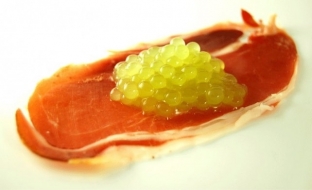
Molecular Cuisine: Sous Vide Technology
Sous-vide cooking requires water baths with thermostats, the temperature of which remains constant throughout the cooking time. This is one of the most popular cooking methods for chefs who want the perfect look of molecular cuisine, not just great taste and texture.
For meat lovers, we offer Sous Vide technology of molecular cuisine, i.е. when a dish is cooked in a vacuum.
- Steak in coffee oil.
Ingredients:
For steak:
- 450 gr. pork steak;
- 75 gr. coffee oil;
- 240 gr. spinach;
For coffee oil:
- 200 gr. oils;
- 100 gr. coffee beans.
- Making coffee oil:
- Evacuumize the ingredients in a bag and cook in a water oven at 90оC for 3 hours.
- Strain the oil.
- Cooking steak:
- Sear the steak on all sides. Cool down.
- Pour coffee oil into a vacuum and marinate at a temperature (from 52oC to 70oC).
- Deep fry the marinated steak at 200oC for 30 seconds. or treat with a burner.
- Brush the finished steak with coffee oil.
- Sweat the spinach in coffee oil over medium heat.
- Serve with portioned steak slices on spinach.
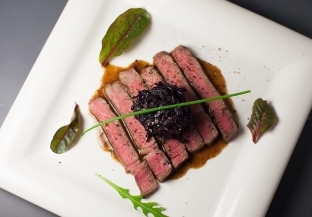
Try making herbal extracts (thyme, rosemary) or saturating butter with the taste of smoked fish – and you will appreciate the benefits of low temperature cooking technology. Molecular cuisine dishes will not let you get bored.
Love pork but find it too fatty? Only not in molecular cuisine dishes – our recipes will allow you to cook your favorite pork without excess fat, while maintaining the taste of your favorite meat.
- Pork cheek with celery puree.
Ingredients:
- 1600 gr. pork cheek;
- 800 gr. celery root;
- 195 ml. cream;
- 15 ml. lemon juice;
- salt;
- 40 gr. butter;
Serving:
- green onions;
- pickled apples.
- Separate the cheek meat from the skin, put it in a vacuum container, cook Sous Vide for 12 hours at 62оС. Then fry under light pressure.
- Prepare celery puree: cut peeled root into 0.5 cm strips and cook Sous Vide 90 min. at 85 degrees Celsius (85oC). Combine the finished celery in a blender with lemon juice, salt, butter and cream. Shake and wipe.
- Serve with pickled apple wedges, laying the pork cheek on a pillow of celery puree.
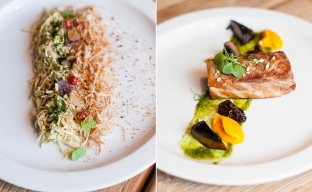
After a delicious hot dish, no one will refuse a light, melt-in-the-mouth, refreshing dessert!
Molecular cuisine: foam (espuma)
Molecular cuisine in the form of foam (espuma) is prepared in rather complex ways. Sauces — these are traditions, and espumas — a new kind of tradition in a lightweight form and amazing taste. Foams make you break away from the basics of classic French cuisine. They are always light and airy, while sauces can be both liquid and thick. The appearance of espum dishes is as colorful as an artist's palette.
Berry season is good every year. But sometimes you really want something like that, fresh and unusual in appearance. Prepare a raspberry dessert using the molecular kitchen method.
- Raspberry Foam
Ingredients:
- 2 textures Agar;
- 500 gr. raspberries;
- 250 ml. milk;
- 125 ml. cream;
- gas N2O.
- Mash the raspberries and heat to a boil, strain from the seeds. Take 220 gr.
- Take 220 gr. berries, mix with milk, add agar.
- Bring to a boil and gradually add the cream, cool.
- Refrigerate for 1 hour to set. Beat with a blender.
- Fill the siphon with the mass. Fill the siphon with gas.
- Shake for 8 seconds.
This dessert can be served hot or cold, solo or as an accompaniment. In any case, the taste and aroma is simply amazing!
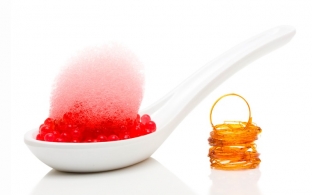
For coffee lovers, you can make a light coffee dizziness from chilled espresso.
- Espresso foam.
Ingredients:
- 325 ml. chilled espresso;
- 125 ml. cream 36%;
- 75 gr. sugar;
- 4 gr. gelatin.
Cooking:
- Pour the gelatin with cold water.
- Heat 100 ml. espresso up to 60oC.
- Introduce sugar and gelatin, stirring, dissolve them.
- Pour off the rest of the espresso and chill.
- Pour in the cream, stir.
- Pour into 0.5 l. siphon, fill with gas N2O.
- Shake vigorously and refrigerate for several hours before serving.
Serve this wonderful molecular cuisine dish in a beautiful tall glass.
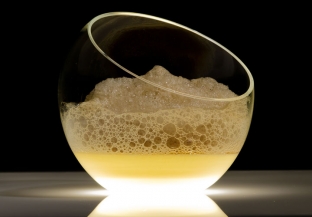






Add a comment